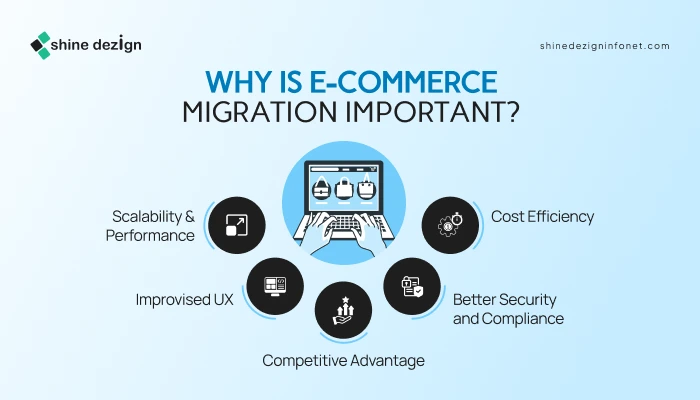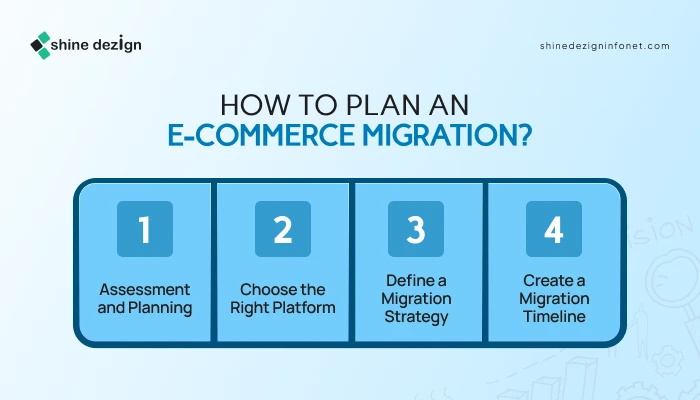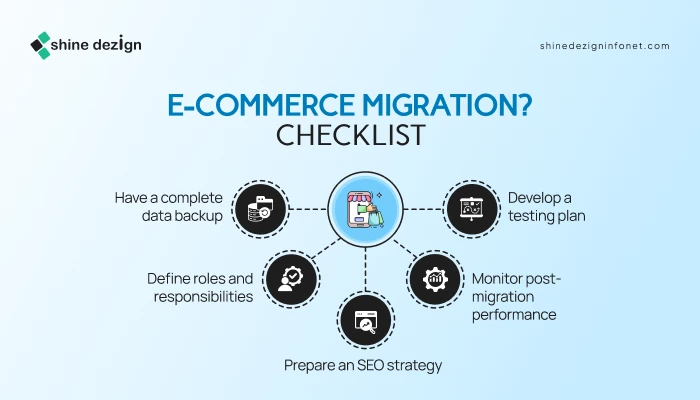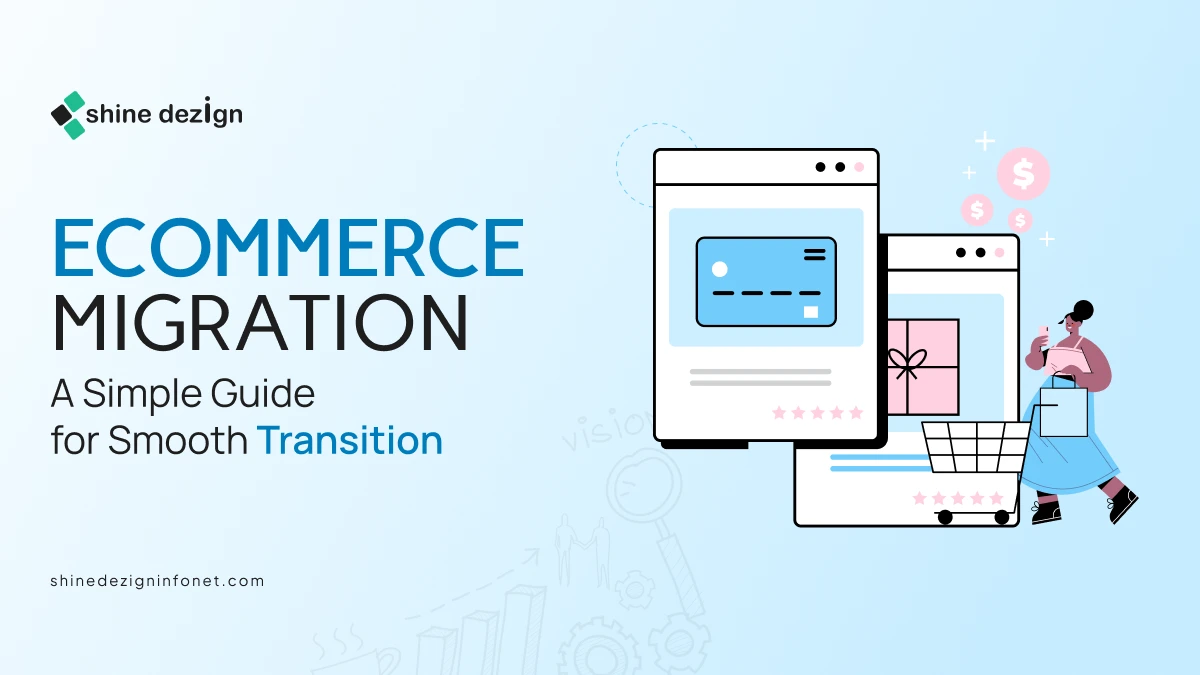Table of Contents
More than 1 in 4 eCommerce companies are willing to switch to eCommerce platforms. This means that most businesses are not happy with their platform anymore. Are you also planning to switch your eCommerce platform? This guide will explore how you can migrate to eCommerce, including a step-by-step process. Let’s get started.
What is eCommerce Migration?
eCommerce migration is transferring an online store from one platform to another, often driven by the requirement for better scalability, performance, and modern features. This transition impacts online business from product catalog and client information to custom integration, SEO rankings, and user experience.
Organizations mainly consider eCommerce site migration when their current software does not fulfill their business needs, whether due to technological limitations, high operational costs, or poor site performance.
E-commerce Migration Statistics
- 76% of B2B e-commerce sellers and 27% of retailers are actively looking to switch to e-commerce platforms.
- Businesses’ expectations of the price of migrating platforms vary widely, with the majority planning to spend between
$25,001 and $500,000. - At almost 70%, Shopify was the most migrated platform, followed by WooCommerce at around 13%.
Why is eCommerce Migration Important?
 eCommerce site migration is more than a technical update. It’s a strategic move that impacts your business growth. Here’s why it is crucial;
eCommerce site migration is more than a technical update. It’s a strategic move that impacts your business growth. Here’s why it is crucial;
Scalability & Performance
Most platforms can manage rising traffic and larger product catalogs more effectively, ensuring your store remains responsive and fast during peak hours.
Improvised UX
Modern design capabilities, faster loading times, and AI-driven customization tools contribute to a better shopping experience that engages clients.
Competitive Advantage
Migrating to a strong platform enables businesses to stay ahead by adopting top-notch features and integration like marketing automation, headless commerce, and omnichannel capabilities.
Better Security and Compliance
Outdated platforms mostly lack the vital security protocols to protect sensitive client data. Newer solutions provide built-in security measures and compliance with industry standards.
Cost Efficiency
High maintenance costs associated with legacy systems can weigh down business growth. Migration to a cloud-based eCommerce solution decreases costs by eliminating the requirement for expensive on-premises infrastructure.
Reasons why eCommerce migrates to other platforms
eCommerce migration is not a decision businesses take randomly. It’s often driven by necessity. As companies evolve, restrictions in current eCommerce platforms become apparent, prompting the requirement for a more robust solution. Let’s check out some common reasons businesses migrate to their eCommerce platforms.
1. Performance Issue
As per the data, the average load speed of the top 100 websites is 2.5 seconds on desktop and 8.6 seconds on mobile. Therefore, the page speed is not just about time; it takes more time for the first element to appear. Low performance not only frustrates clients but also leads to revenue loss. 67% of the businesses reported lost revenue due to low website performance.
2. High Maintenance Cost and Total Cost of Ownership
Legacy platforms mostly have hidden charges, including licensing fees, maintenance, and expensive updates. Also, the total cost of ownership can exceed the initial investment. Therefore, migrating to a modern, cloud-based eCommerce platform can decrease these prices while improving overall efficiency.
3. Limited Integration Capabilities
Most eCommerce operations depend on seamless integrations with third-party services like CRM systems, payment gateways, and inventory management solutions. Most old platforms may lack the flexibility to integrate with vital tools, restricting business growth opportunities.
4. Security and Compliance Risks
Platforms that are not updated and outdated are often suspicious security breaches and lack compliance with updated data protection regulations like GDPR. Migrating to a platform with built-in security measures ensures that sensitive client data remains updated and protected.
Key challenges in migrating to your eCommerce store
Accurate Data Transfer
One of the biggest challenges in eCommerce platform migration is ensuring a flawless transfer of critical data such as customer accounts, product catalogs, order history, and payment details. Any loss or corruption during migration can result in missing products, incorrect pricing, or broken user profiles, directly impacting sales and customer trust.
Solution: Perform thorough backups, test data imports in a staging environment, and validate records post-migration to ensure nothing is lost or altered.
Preserving Search Engine Rankings
Website migrations can wreak havoc on your SEO if not handled carefully. Changes to your site’s URL structure, page hierarchy, or metadata can significantly drop organic traffic.
Solution: Preserve key SEO elements like URLs, meta descriptions, and internal linking. Use 301 redirects to guide search engines and users from old URLs to new ones and submit updated sitemaps to Google Search Console.
Post-Migration Monitoring
The work doesn’t end once the migration is complete. Undetected issues such as broken links, functionality errors, or slow load times can frustrate users and lead to lost revenue.
Solution: Monitor your site closely in the days and weeks following the migration. Run audits for broken links, test core functionality (checkout, login, mobile responsiveness), and watch analytics for unusual drops in traffic or conversions.
How to Plan an eCommerce Migration?
 Without a strategic plan, you cannot migrate to your eCommerce store. Proper planning with your team can help you move to your store successfully.
Without a strategic plan, you cannot migrate to your eCommerce store. Proper planning with your team can help you move to your store successfully.
Step 1: Assessment and Planning
As per Gartner, around 83% of data migrations fail due to implementation issues or being over budget. So, assess your project with proper planning. You must define your business goals, audit your existing platform, and analyze key metrics.
Key factors to consider:
- Evaluate site performance and user experience (UX)
- Inventory all data (products, customers, orders)
- Identify SEO-critical pages
Step 2: Choose the Right Platform
Select an eCommerce platform that aligns with your business goals, budget, and technical requirements. Consider scalability, integrations, design flexibility, and support.
Popular options: Shopify, WooCommerce, BigCommerce, Magento, etc.
Key factors to consider:
- Business size and growth potential
- Customization and ease of use
- SEO and mobile friendliness
- Security and support
Step 3: Define a Migration Strategy
Plan how you’ll move your data and features from the old platform to the new one. Decide whether you migrate manually, use automated tools, or hire a migration expert.
Strategies to Include:
- Data mapping (matching old data fields to new ones)
- URL structure planning
- Redirect strategy (301 redirects)
- Testing environment setup
Step 4: Create a Migration Timeline
Establish a detailed timeline with clear milestones. Include preparation, testing, content migration, design implementation, and post-launch monitoring phases.
Tips for building your timeline:
- Avoid peak traffic or sales seasons
- Allocate time for testing and bug fixes
- Set internal deadlines for reviews and approvals.
eCommerce Migration Checklist
 Having a well-prepared checklist ensures you cover all the factors of the migration process. Let’s check out the eCommerce Migration checklist.
Having a well-prepared checklist ensures you cover all the factors of the migration process. Let’s check out the eCommerce Migration checklist.
Have a complete data backup
Protect your business by backing up all client information, order history, and product data.
Define roles and responsibilities
Assign a project manager to oversee the migration and ensure accountability across teams.
Prepare an SEO strategy
Ensure you update URLs, create 301 redirects, and optimize metadata to preserve your search rankings.
Develop a testing plan
Test every factor of the new platform, from performance functionality to Analysis of every aspect, before the final launch.
Monitor post-migration performance
Track and analyze key metrics and customer feedback to identify and resolve issues quickly.
Summing Up
Migrating your eCommerce store to Shopify doesn’t have to be overwhelming. You can ensure a smooth and successful transition with proper planning, the right tools, and a clear strategy. Whether you’re moving from WooCommerce, Magento, BigCommerce, or any other platform, Shopify offers the flexibility, scalability, and user-friendly experience modern businesses need. Focus on preserving your data, optimizing your design, and testing thoroughly before going live. A smooth migration protects your brand and sets the foundation for future growth and better customer experiences.

















